| Bomber Girls - The Art of Nose Art When someone says "nose art," the term conjures up images of World War II fighter planes careening through the sky combating the Luftwaffe while sporting pin-up girls, predatory eagles or "Old Glory" -- and, in some cases, all of the above. |
 |
During World War II, pin-ups emerged from the fine airbrushed art of Alberto Vargas, whose images were the most sought-after section of the popular magazine, Esquire. With thousands of airplanes droning off to war, noseart emerged as the aviator's unique calling card. Although the Army Air Force attempted to ban and censor noseart on several occasions, ultimately, the art would remain. <-- Click me for a full view |
|
It would be an understatement to call most of the clothing on pin-up girls (as they were called) "painted on". As you can see, the clothing was not meant to hide very much at all. Many aircrews paid their artists to make sure that even this little bit of clothing was removed. Some planes were even named accordingly, "O-O Nothing!", "Off We Go", "Surprise Attack", "Over Exposed", "Tantalizing Takeoff", and dozens of others were popular double-entendres. Click me for a full view --> |
 |
 |
Some poster art of the era used pin-up inspired imagery of women, often in military clothes. This type of art was most often used for War Bond drives and morale-boosters on the home front. Industry often played a part, putting up posters in company cafeterias and at the clock where you got your card punched at the beginning and end of each day. <-- Click me for a full view |
| The Pacific War against Japan involved long-range missions and hours of miserable heat, rain, and mud. The Hawaiian pin-up, complete with a lei, could only serve to remind the airmen and ground crews of their time back east. Click me for a full view --> |
 |
 |
It was no mystery why these artworks ended up in dozens of variations on so many airplanes. It reminded the airmen of home and of better times. And in a day when death could be just hours away, it gave them something else to think about. Most were women who you could go home to, if you lived to go home at all. And that is why they formed such a central place at the frontlines of the air war. They represented hope and home. Good luck, chum, they would whisper, my dreams are riding with you. <-- Click me for a full view |
| The metaphor of looking through a keyhole for a sneak peek was always popular, even if quite politically incorrect in today's day and age. Nonetheless, despite the artwork, the airmen were typically nothing short of absolute gentlemen, particularly at 8th and 9th Air Force bases around England. Click me for a full view --> |
 |
 |
The finest pin-ups were torn from the pages of Esquire Magazine. Each artwork was published with a poem by Phil Stack. These poems were designed to rhyme and present without much subtlety, again using the double-entendre to effect. One went simply, "I'm learning some commando tricks. / For keeping fit, they're dandy, / And when you men come home again, / They're apt to come in handy!" <-- Click me for a full view |
| A few of the pin-ups were so sexy and provocative that they could only be called bombshells. Some were Hollywood starlets, some were imaginary. Almost all of them were proportioned beyond mere genetics. What was the ideal woman of the 1940s and 1950s wouldn't make it in the world of today's supermodels. The twiggy, overly thin look that dominates the fashion industry of the 1990s contrasts sharply with the blushing, well-proportioned female form of the war years. Click me for a full view --> |
 |
 |
Its value in terms of morale was unquestioned. In the end, it emerged as a defining element of the era, gracing everything from the noses of airplanes, to leather jackets, to the walls of barracks huts and O-Clubs across Europe and the Pacific. If anything the pin-ups that inspired a generation of aviators were quite practical. Some were exotic, to be sure, but virtually all were posed in positions that seemed quite acceptable to the gentleman's view of the era. <-- Click me for a full view |
| Some pin-up art retains its charm and is still in use today. The 1943 Esquire pin-up, "There'll Always Be A Christmas" is the official nose art of Virgin, one of England's largest commercial air carriers. What once graced the nose of countless 8th Air Force B-17s can now be seen on the sides of Virgin's fleet of Boeing 747s. Click me for a full view --> |
 |
 |
The Gulf War saw a resurgence of nose art. With hundreds of airplanes and thousands of the Air Force's best deployed to Saudi Arabia, Bahrain, Oman, Qatar, and the Emirates, it didn't take long for nose art to reappear. As in the past, it was allowed to stay, but only for the duration of the war. This example, painted on the side of a KC-135 at Riyahd, is typical of much of the nose art in the Gulf. Arabic numerals sit above the Air Force's own, testimony to the location and the relationship that developed with Saudi ground crews. |
|
As Desert Shield wound down and the coalition forces in Southwest Asia prepared for the assault against Saddam's entrenched ground forces in Kuwait, thoughts of home and the holidays again entered the mind of aircrew members across the region. This airplane was painted with a fitting holiday theme, Santa being pulled in his sleigh by his magical flying camels, err... wasn't that supposed to be reindeer? |
 |
 |
Much of Desert Storm's nose art was based not on pin-ups but on science fiction and fantasy art. This tradition continues and grows as a new generation of artists paint based on their own influences. After all, it has been a long time since Esquire featured a pin-up as a centerfold. This C-130 is a classic example of the new genre. While popular in the field, there are countless nose art aficionados who prefer the old, somewhat less politically correct look. |
| It seems fitting that Disney characters and movie influences should return to the fore. This Desert Storm C-130 is emblazoned with the ever popular Roger Rabbit -- ever popular that is, but still a close second behind his cartoon wife. |
 |
 |
Another aerial refueler declares the very essence of pilotage -- cool as a cat, smooth as silk. You just can't beat confidence. And so much for popular influences: wasn't this the ubiquitous Frito-Lay mascot of an ad campaign from a few years back? |
| Another Gulf War C-130 cargo airplane boasted the nose art, "The Desert Phoenix". You could say this as much as about a military that came back from the Vietnam blues to fight and win it all as you could about nose art itself. Without the atmosphere of the Gulf, there is little question that this generation would not have seen much more than a smattering of artwork on the sides of airplanes. |
 |
 |
Who said you had to be cute or sexy to be nose art? The popular comic book and later movie character, the Mutant Ninja Turtles made showing more than once during the Gulf War. Here, a 435 TAW C-130 is painted with the likeness of Donatello, now renamed the "Desert Ninja". |
|
A major role of nose art is in building morale and expressing the pride and strength of the forces. Here, a bulldog chews up Saddam's Iraq, apt and very accurate foresight into the days to come. |
 |
 |
The 5th Bombardment Wing painted a number of its aircraft, including this one which bears the name, "America's Pride". A fitting tribute to the attitude of military aviators, like all military men they remain among the most patriotic and dedicated people in the country. |
|
You don't have to be a pirate to get the message here. From the hostage crisis with Iran to the Iraqi invasion of Kuwait and to dozens of terrorist actions, Americans have harbored a touch of ill will toward the two-bit dictators that rule a number of the countries in the Middle East. This 435th TAW C-130 is ready to even the score -- finally against an enemy that is concrete, military, and spoiling for a "fair" fight. In the end, the Gulf War extracted more than its due, with over 250,000 Iraqi soldiers killed for loss of just about a hundred from the coalition forces. |
 |
 |
Considered by many to be the finest technical example of nose art from the Gulf War, this beautifully rendered pig carries the motto, "Ol Lightnen" and the plane's tail number 0005. Painted on the side of a KC-135 refueller out of Riyahd, it is one of the classics of the era. |
|
The B-17G Shoo Shoo Baby flew 24 combat missions in WW II with the 91st Bomb Group, known as "The Ragged Irregulars". The plane was based at Bassingbourn, England. Its first mission was the bombing of Frankfurt, Germany, on March 24, 1944. The plane ended its combat career after taking battle damage during a mission to Posen, Poland, on May 29, 1944. Today, the plane is at Wright-Patterson AFB in the US Air Force Museum. |
 |
 |
The Duck goes to war.... Painted on the side of a restored, flying P-51D, this nose art captures an era when Walt Disney freely offered his studio's talents to design unit patches and symbols for Americans going to war. Beyond the Vargas pin-ups, Walt Disney's art did more to define the motif of nose art than any other single source. |
| Yankee Lady is another restored example of a B-17G. Frequently seen at airshows around the country, it is one of the finest examples of a Flying Fortress still capable of taking to the air. If you've never heard the power of four Pratt & Whitney engines at full tilt, you're missing a real piece of history. |
 |
| |




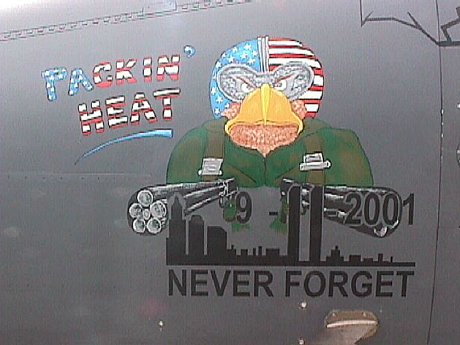
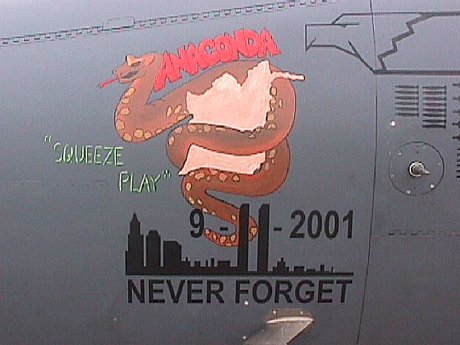
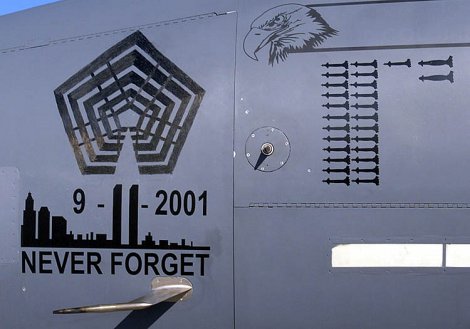
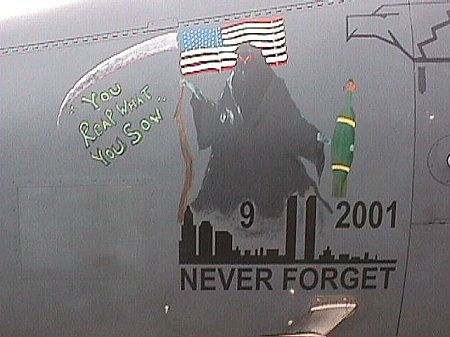
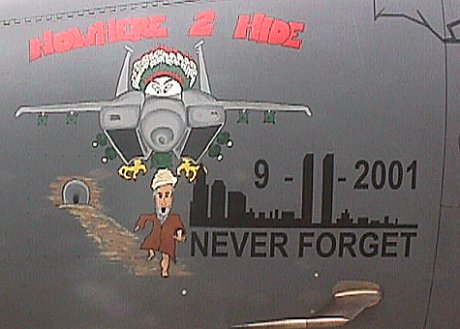



































 Me too.
Me too.


